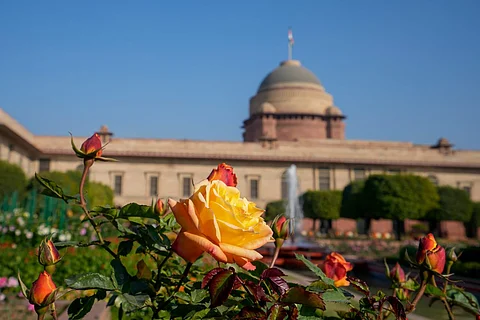

The iconic Mughal Gardens at the Rashtrapati Bhavan will now be known as 'Amrit Udyan'. BJP leaders hailed the decision, claiming that it shredded yet another symbol of colonialism, while the opposition parties advised the government to focus on creating jobs and controlling inflation instead.
The Trinamool Congress and the Communist Party of India rubbished the move with the Left party terming it an "attempt to rewrite history". CPI general secretary D Raja said this name change has been going on for quite some time and no one knows when it will end. "The RSS' agenda is to rewrite Indian history and redefine nationhood. When we celebrate our Republic, it is for the people to stand up and safeguard our secular, democratic Indian Republic. India is not a theocracy, India is a democracy," he said.
Bahujan Samaj Party (BSP) chief Mayawati took a dig at the government, asking if the problems of the country and its people will go away by changing names. Congress' Rajya Sabha MP Imran Pratapgarhi sarcastically said the move will "give relief" to people troubled by the falling Adani shares.
Former Union Minister Rajyavardhan Rathore welcomed the decision to change the name. "The Congress had imposed the name Mughal Garden on the world-famous garden of Rashtrapati Bhavan. Thank you Modi ji for erasing the name of the invading Mughals and making 'Amrit Udyan'," he said in a tweet in Hindi.
The resplendent gardens are open to the public once a year and people can visit from January 31 this time. President Droupadi Murmu inaugurated the opening of the gardens of Rashtrapati Bhavan — Udyan Utsav 2023 — on Sunday, January 29. The renaming of the Mughal Gardens comes months after the renaming of the Rajpath to Kartavya Path by the government. The renaming of the stretch and other institutions is in line with its effort to remove any trace of the ‘colonial mindset’, the Union government has maintained.
The celebrated Mughal Gardens, a horticultural paradise in the sprawling premises of the Rashtrapati Bhavan, is spread over 15 acres and boasts of over 150 varieties of roses, tulips, Asiatic lilies, daffodils and other ornamental flowers. The history of the famed gardens of the Rashtrapati Bhavan is as rich as its scented stocks of flowers, and intertwined with the creation of the President's House (originally built as Viceroy's House), designed by architect Sir Edwin Lutyens.
In 1911, King George held a grand Durbar in Delhi where he also announced the shifting of the imperial capital from Calcutta to Delhi. Lutyens and Sir Herbert Baker gave shape to the new imperial capital, with the Viceroy's House and the North Block and South Block as the centrepiece of 'New Delhi', as the city was officially named in 1926.
After Independence, the Viceroy House became the Rashtrapati Bhavan, and the Kingsway, the ceremonial boulevard which runs from Raisina Hill to India Gate, was renamed to Rajpath. After renaming of the Mughal Gardens on Saturday, the Rashtrapati Bhavan secretariat has also updated its website, which carries a brief history of the celebrated gardens.
"Spread over a vast expanse of 15 acres, Amrit Udyan has often been portrayed, and deservedly so, as the soul of the Presidential Palace. The Amrit Udyan draws its inspiration from the Mughal Gardens of Jammu and Kashmir, the gardens around the Taj Mahal and even miniature paintings of India and Persia," reads the description on the website.
Sir Edwin Lutyens had finalised the design of the gardens as early as 1917. However, it was only during 1928-1929 that the plantings were done. His collaborator for the gardens was Director of Horticulture, William Mustoe, it says.
The building of Rashtrapati Bhavan has two different styles of architecture, Indian and western. Similarly, Lutyens brought together two different horticulture traditions together for the gardens, the Mughal style and the English flower garden. Mughal canals, terraces and flowering shrubs are beautifully blended with European flowerbeds, lawns and private hedges, the statement said. Rose remains a key feature of the famed gardens even today. The gardens boast of growing 159 celebrated varieties of roses which blossom primarily in the month of February and March.
The varieties of roses in the gardens include Adora, Mrinalini, Taj Mahal, Eiffel Tower, Modern Art, Scentimental, Oklahoma (also called black rose), Belami, Black Lady, Paradise, Blue Moon and Lady X. The Mughal Gardens also include roses named after people of national and international fame such as Mother Teresa, Raja Ram Mohan Roy, Abraham Lincoln, John F Kennedy, Jawahar Lal Nehru, Queen Elizabeth, and Christian Dior, amongst others. Arjun and Bhim, from the Mahabharata, also find a place in the presidential palace, the website says.
"On the occasion of the celebrations of 75 years of Independence as Azadi ka Amrit Mahotsav', the President of India is pleased to give a common name to the Rashtrapati Bhavan gardens as Amrit Udyan'," Navika Gupta, Deputy Press Secretary to the President, said in a statement. "In Christopher Hussey's 'The Life of Sir Edwin Lutyens', Sir Lutyens' wife has written that the garden was a paradise," the statement said.
Apart from roses, tulips, Asiatic lilies, daffodils, hyacinths and other seasonal flowers beautify the gardens of Rashtrapati Bhavan. There are more than 70 varieties of seasonal flowers, including exotic bulbous and winter flowering plants. The garden also grows 60 of the 101 known types of bougainvillaeas. Edging and flowering of flower beds are done with alyssum, daisies, and pansies, among others. The grass that covers the garden is the doob grass, which was originally brought from Calcutta (now Kolkata) when the Mughal Gardens were being planted, it says.
"The Gardens has almost 50 varieties of trees, shrubs and vines, including the Moulsiri tree, Golden Rain tree, flower-bearing Torch Tree and many more. At present, over 300 permanent and casual employees are deployed for the development and maintenance of the gardens of Rashtrapati Bhavan," the description reads.